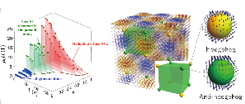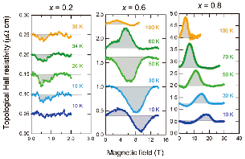Emergent Transport Phenomena in the Course of Multiple Topological Transitions in MnSi1-xGex
N. Kanazawa, Y. Tokura, and M. Tokunaga
Interplay between topological spin textures and conduction electrons produces giant effective magnetic field called emergent magnetic field, leading to various electromagnetic functionalities for next-generation memory devices and energy-harvesting technology. Skyrmion and hedgehog spin structures are representative examples, which show two- and three-dimensional (2D and 3D) topological spin arrangements, respectively. Reflecting their topological properties, distinct emergent field distributions and each characteristic response are realized, i.e., flux-line- and monopole-like behaviors in skyrmion and hedgehog systems.

Fig. 1. (left) Variation of magnetic phase diagrams in MnSi1-xGex. The three colors represent different topological magnetic phases. (right) Schematic illustration of the new hedgehog lattice state identified in this study.

Fig. 2. Representative profiles of topological Hall resistivity for three different magnetic states (x = 0.2 for SkL, x = 0.6 for fcc HL, and x = 0.8 for cubic HL).
By synthesizing alloys of skyrmion- and hedgehog-hosting compounds (MnSi and MnGe), we investigate the transformation process between skyrmion and hedgehog spin textures, where new type of topological phase transition is expected. We also perform high-magnetic field measurements on Hall resistivity to unravel the emergent field profiles upon complete unwinding those highly-stable magnetic knots. Precise transport measurements with μΩ-resistance resolusion were achieved by utilizing non-destructive pulse magnets energized by capacitor banks and a flywheel DC generator installed at International MegaGauss Science Laboratory of Institute for Solid State Physics (ISSP).
We have observed three different magnetic phases with varying composition x in MnSi1-xGex. As shown in the magnetic phase diagrams (Fig. 1), each magnetic phase exhibits a unique magnetic field value for the transition to ferromagnetic state (approximately 1 T for 0 < x < 0.3, 10 T for 0.3 < x < 0.7, and 20 T for 0.7 < x < 1), which is suggestive of the difference in topological property of the winding spin texture. In particular, we identified a new type of hedgehog lattice in MnSi1-xGex with intermediate composition x = 0.4 – 0.6, i.e., at the expected topological magnetic transition between the 2D skyrmion lattice (SkL) and the 3D hedgehog lattice (HL). This magnetic state consists of hedgehogs and anti-hedgehogs aligned in face-centered-cubic positions (Fig. 1). We also revealed emergent field profiles characteristic to each magnetic state as topological Hall effect (Fig. 2). There observed much difference in magnitudes and H-dependence, again contrasting the three topological phases.
In conclusion, we demonstrate the transitions among distinct topological spin textures, namely 2D SkL and two classes of 3D HLs, which are simply induced by controlling lattice constant or chemical pressure. The present study suggests a new route for the direct manipulation of the spin-texture topology. Furthermore, the established precise high-field transport measurement technique will contribute to detection of emergent electromagnetic fields appearing as less-dissipative current and concomitant small resistance change.
References
- [1] Y. Fujishiro, N. Kanazawa, T. Nakajima, X. Z. Yu, K. Ohishi, Y. Kawamura, K. Kakurai, T. Arima, H. Mitamura, A. Miyake, K. Akiba, M. Tokunaga, A. Matsuo, K. Kindo, T. Koretsune, R. Arita, and Y. Tokura, J. Phys. Soc. Jpn. 75, 043707 (2006).
